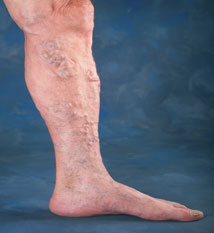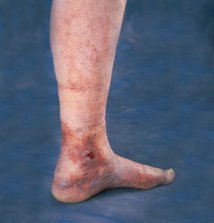Venefit™ (formerly VNUS Closure™) Procedure
If you suffer from varicose veins, you’re not alone. Some 25 million Americans face a daily struggle with the swollen, rope-like veins that can cause throbbing pain, severe swelling, and heavy-feeling, tired legs.
 Half of all Americans over 50, and two-thirds of women over 60, have the condition. And many have dealt with it for decades, because varicose veins can appear even in teenagers.
Half of all Americans over 50, and two-thirds of women over 60, have the condition. And many have dealt with it for decades, because varicose veins can appear even in teenagers.
Heredity is a factor in venous reflux disease (the primary cause of varicose veins) – if your parents or siblings have had varicose veins, you’re more likely to develop them – and people who are obese or have had multiple pregnancies are particularly susceptible, because the extra weight adds strain to the veins. Women are more vulnerable to the problem than men, partly because the hormonal changes brought on by menstruation, menopause and hormone-based drug therapy can relax vein walls and cause venous reflux.
Your lifestyle, particularly physical activity, can affect your odds of developing varicose veins as well. People whose careers require them to stand in place for long periods of time – nurses, teachers, waitresses, flight attendants and other service personnel, for example – have a higher-than-average risk of venous disease. So do people who do a good deal of heavy lifting.




Once it appears, venous reflux disease never goes away by itself – it’s a progressive condition that can only worsen unless treated. Fortunately, the minimally-invasive, device-based advances in medical technology that have so profoundly impacted heart, lung and brain surgery in recent years are now having a similarly revolutionary impact on the treatment of varicose veins.
Frequently Asked Questions
What is superficial venous reflux?
Superficial venous reflux is a condition that develops when the valves that usually keep blood flowing out of your legs become damaged or diseased. This causes blood to pool in your legs. Common symptoms of superficial venous reflux include pain, swelling, leg heaviness and fatigue, as well as varicose veins in your legs.
What is the Venefit™ Procedure?
The Venefit™ (formerly VNUS Closure™) Procedure is a minimally invasive treatment for superficial venous reflux. A thin catheter is inserted into the vein through a small opening. The catheter delivers radiofrequency (RF) energy to the vein wall, causing it to heat, collapse, and seal shut.
How does it work to treat superficial venous reflux?
Since valves can’t be repaired, the only alternative is to re-route blood flow through healthy veins. Traditionally, this has been done by surgically removing (stripping) the troublesome vein from your leg. The Venefit™ Procedure provides a less invasive alternative to vein stripping by simply closing the problem vein instead. Once the diseased vein is closed, other healthy veins take over and empty blood from your legs.
How is the Venefit™ Procedure different from vein stripping?
During a stripping procedure, the surgeon makes an incision in your groin and ties off the vein, after which a stripper tool is threaded through the saphenous vein and used to pull the vein out of your leg through a second incision just above your calf.
In the Venefit™ Procedure, there is no need for groin surgery. Instead, the vein remains in place and is closed using a special (Closure) catheter inserted through a small puncture. This may eliminate the bruising and pain often associated with vein stripping (i.e., that may result from the tearing of side branch veins while the saphenous vein is pulled out). Vein stripping is usually performed in an operating room, under a general anesthetic, while the Venefit™ Procedure is performed on an outpatient basis, typically using local or regional anesthesia.
Three randomized trials of the Venefit™ Procedure vs. vein stripping, including the most recent multi-center comparative trial, show very similar results. In the multi-center comparative trial, the Venefit™ Procedure was superior to vein stripping in every statistically significant outcome. In the study, 80.5% of patients treated with the Venefit™ Procedure returned to normal activities within one day, versus 46.9% of patients who underwent vein stripping. Also, Venefit™ patients returned to work 7.7 days sooner than surgical patients. Patients treated with the Venefit™ Procedure had less postoperative pain, less bruising, faster recovery and fewer overall adverse events.1
How long does the Venefit™ Procedure take?
The Venefit™ Procedure takes approximately 45-60 minutes, though patients normally spend 2-3 hours at the medical facility due to normal pre- and post-treatment procedures.
Is the Venefit™ Procedure painful?
Patients report feeling little, if any, pain during the Venefit™ Procedure. Your physician will give you a local or regional anesthetic to numb the treatment area.
Will the procedure require any anesthesia?
The Venefit™ Procedure can be performed under local, regional, or general anesthesia.
How quickly after treatment can I return to normal activities?
Many patients can resume normal activities immediately.2 For a few weeks following the treatment, your doctor may recommend a regular walking regimen and suggest you refrain from very strenuous activities (heavy lifting, for example) or prolonged periods of standing.
How soon after treatment will my symptoms improve?
Most patients report a noticeable improvement in their symptoms within 1-2 weeks following the procedure.
Is there any scarring, bruising, or swelling after the Venefit™ Procedure?
Patients report minimal to no scarring, bruising, or swelling following the Venefit™ Procedure.
Are there any potential risks and complications associated with the Venefit™ Procedure?
As with any medical intervention, potential risks and complications exist with the Venefit™ Procedure. All patients should consult their doctors to determine if their conditions present any special risks. Your physician will review potential complications of the Venefit™ Procedure at the consultation , and can be reviewed in the safety summary. Potential complications can include: vessel perforation, thrombosis, pulmonary embolism, phlebitis, hematoma, infection, paresthesia (numbness or tingling) and/or skin burn.
Is the Venefit™ Procedure suitable for everyone?
Only a physician call tell you if the Venefit™ Procedure is a viable option for your vein problem. Experience has shown that many patients with superficial venous reflux disease can be treated with the Venefit™ Procedure.
Is age an important consideration for the Venefit™ Procedure?
The most important step in determining whether or not the Venefit™ Procedure is appropriate for you is a complete ultrasound examination by your physician or qualified clinician. Age alone is not a factor in determining whether or not the Venefit™ Procedure is appropriate for you. The Venefit™ Procedure has been used to treat patients across a wide range of ages.
How effective is the Venefit™ Procedure?
Data from a prospective multicenter study have shown 97.4% vein occlusion 1 year post-treatment.3
What happens to the treated vein left behind in the leg?
The vein simply becomes fibrous tissue after treatment. Over time, the vein will gradually incorporate into surrounding tissue. One study reported that 89% of treated veins are indistinguishable from other body tissue one year after the Venefit™ Procedure was performed.5
Is the Closure treatment covered by my insurance?
Many insurance companies are paying for the Venefit™ Procedure in part or in full. Most insurance companies determine coverage for all treatments, including the Venefit™ Procedure, based on medical necessity. The VNUS® Venefit™ Procedure has positive coverage policies with most major health insurers. Your physician can discuss your insurance coverage further at the time of consultation.
What are patients saying about the Venefit™ Procedure?
98% of patients who have undergone the Venefit™ Procedure are willing to recommend it to a friend or family member with similar leg vein problems.
1. Lurie F, Creton D, Eklof B, Kabnick LS, Kistner RL, Pichot O, et al. Prospective randomized study of endovenous radiofrequency obliteration (Closure) versus ligation and stripping in a selected patient population (EVOLVES study). J Vasc Surg 2003; 38:207-14.
2. Goldman, H. Closure of the greater saphenous vein with endo radiofrequency thermal heating of the vein wall in combination with ambulatory phlebectomy: preliminary 6-month follow-up. Dermatol Surg 2000; 26:452-456.
3. Dietzek A, Two-Year Follow-Up Data From A Prospective, Multicenter Study Of The Efficacy Of The ClosureFAST Catheter, 35th Annual Veith Symposium. November 19, 2008. New York.
4. Pichot O, Sessa C, Chandler JG, Nuta M, Perrin M. Role of duplex imaging in endovenous obliteration for primary venous insufficiency. J. Endovasc Ther 2000; 7:451-9.
5. Weiss RA, Weiss MA. Controlled radiofrequency endovenous occlusion using a unique radiofrequency catheter under duplex guidance to eliminate saphenous varicose vein reflux: A 2-year follow-up. Dermatol Surg 2002; 28:38-42.
